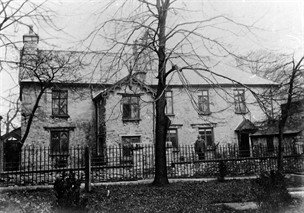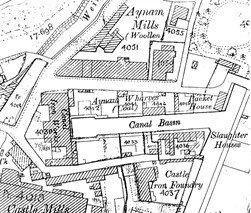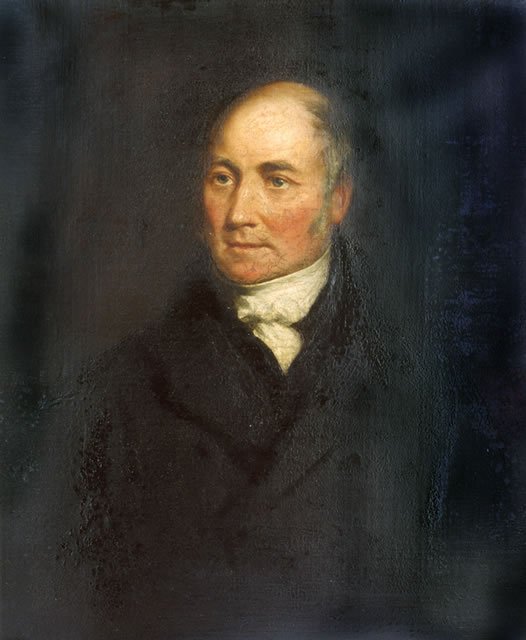The Story of…
The Kendal Canal
A journey through Kendal's lost waterways.
A journey through Kendal's lost waterways.
An ariel view of Kendal c1940, showing route of Canal
The story of the Lancaster to Kendal Canal begins with a grand opening on the 18th June 1819, which was followed by almost thirty years of growth and prosperity until in 1846 the railway came to Kendal, to compete for goods and passengers.
There was a gradual decline from 1846 for the next hundred years until the canal was finally drained and filled in, in the 1960s. There are hopes and plans that it will be brought back to life one day, but that may be many years in the future.
The Canal being filled in
Highgate, 1887
The Kendal of the early 19th century was a very different place from the busy growing town of today. The woollen industry, which had brought such wealth over the centuries, was still operating, together with leather and shoemaking, snuff and tobacco.
In the 19th Century the many industrial yards in Kendal were filled with the noise and clatter of workshops, hand looms, smithies and other small industries. The air would have been filled with the smells from the many tanneries and dye works.

Camms Yard Ropeworks

Collin Croft Blacksmith

K Cycle Works

K Cycle Works

Dockwray Mill
In Kendal in the 1800s water from the river Kent was the only source of power for the five sets of mills within the town boundaries.
Gas did not arrive until 1825, and electricity much later but 19th Century Kendal had much to offer.

Gas Works, Arial Close-up

The Old Grammar School
There was an ancient Grammar School in which the children of the town were taught as well as theatres providing entertainment, and a large assembly room.
Owing to Kendals growing prosperity there were many inns and hostelries.
There was also a huge pack-horse trade operating in the area, Kendal being an important stop on the trade routes for many products.

White Hall Kendal

King’s Arms Stagecoach
Stagecoaches ran daily to and from Kendal as far afield as Manchester and London. Trade went on with all parts of the country and overseas but it was hampered by the state of the roads, although from the 1750s onwards, the Turnpike Acts meant that great improvements were being made.
Kendal was not an isolated little backwater in the far distant north, but it was ready for new development and the canal promised to bring wealth and increased employment to the town and, most importantly, the coal which was needed for local industries and domestic use, as supplies of peat were running out.
By 1793 the Enabling Act was passed to build the Canal from the Wigan and Bolton coalfields to Kendal.
It got as far as Tewitfield by 1797, but the final stretch to Kendal was delayed for the next 22 years due to the wars with France which increased the cost of construction and reduced the supply of capital.
In 1813, work finally began on the final stretch of the canal and was completed six years later at the cost (enormous then) of £60,000.
The grand opening was planned for the 4th April 1819, but it had to be postponed when the embankment burst seven miles south of Kendal.

Canal, Parkside Road

A trip on a Canal Barge
The damaged embankment was repaired in time for the 18th June and the canal was ready. Kendal went wild with excitement. Flags were hoisted on the principle buildings, and cannon were fired throughout the day. Kendal Corporation and its ladies embarked on the Corporation barge, followed by seven other barges and packet boats, all fully laden; the bells rang, the bands played and they floated happily down to Crooklands.
There they met the official party from Lancaster, and all 16 boats returned to Kendal and the cheers of some 10,000 people packed on to Castle Hill. An evening of dining and speeches and a grand ball concluded the festivities.
So what did the new Canal, built with so much navvy labour, so many difficulties and at such expense, bring to Kendal?
It signalled the start of an enormous burst of growth and energy and Kendal just took off!

Canal Head Map, 1912

Canal Barge and Bargee
Much needed cheap coal was brought to the wharves at the Lound and at Canal Head. Limestone from great quarries on Kendal Fell, until now burnt in inefficient kilns using wood and peat, was now burnt in vast quantities using coal and coke, to produce mortar and lime.
An enormous surge in building then followed.
Several kilns were built on Kendal Fell; the fine double kiln at Greenside has recently been saved from dereliction and restored as a reminder of a once great industry.

Greenside Lime Kiln

Francis Webster
The Webster firm of architects and builders were now well established in Kendal, and ready to seize every opportunity.
Alderman Francis Webster was instructed by the Canal Committee in April 1818, to replace the narrow bridge to Castle Mills with a new wider bridge to serve Canal Head.
In May 1818 the foundations were laid and Miller Bridge as it was called was completed by November. They knew how to get on with the job in those days!
The bridge survives today, just as it was built along with Webster's original approach railings and pillars and the date in Roman numerals above the central arch.

Miller Bridge

Websters Marble Works
There was no Aynam Road until 1877, but the Websters developed Bridge Street; the house facing you as you drive over Miller bridge was built as their marble works and showroom.
Bridge Street led to Canal Head and the canal basin.
The canal came up to a basin with an arm lined with coal and slate wharves, where the barges could float down beneath the arches to two great covered warehouses.

Canal Head Aerial View

Canal Head

Canal Head from Castle
At the canal basin were two warehouses which had large doorways opening on to loading bays in Bridge Street for unloading goods on to waiting horses and carts. The arches and doorways are still there within Gilkes' premises.
The canal basin was a busy noisy industrial centre but it was also the starting point for packet boats, a relatively serene mode of transport.
Tickets for these boats could be bought at the ticket office, in a wing of the Canal Head building.
Canal Ticket Office
Packet Boats Poster
The packet boat service began the day after the canal opened. The boats were 70ft long and 6ft wide, with first and second class cabins, and refreshments on board.
Packet Boats left Kendal at 6.00 a.m. for Lancaster and Preston, returning at 8.45 p.m., pulled by pairs of horses changed every four miles. A speed of 8 miles per hour could be reached, sufficient to compete with the fastest mail coaches at 10 miles per hour.
For people who had only ever travelled in jolting carts or on horseback over the rough stony roads, this smooth glide through the glorious countryside must have been a delight. Sadly, it all came to an end almost as soon as the railway opened in 1847 and the boats could not compete.
Waterwitch II
A Canal Barge
The Canal at Stainton
A Canal Barge at Crooklands
Heavy coal barges continued to travel the canal after the coming of the railway, bringing coal into Kendal and taking lime, mortar and other goods out, with entire families living on board.
The barges also had other uses, every year they were cleaned up and filled with excited children in their Sunday best, with their teachers, for an outing to Levens Park or Sedgwick House.
A day of games, races, sticky buns and tea followed. This was often the only holiday of the year for many children, and the tradition continued well into the 20th century.

Canal Trip, Whitsuntide

Sunday School Canal Trip

Rinkfield Skating

Skating at Thompsons Wharf

Skating on Canal near Canal Head
In winter, the canal often froze and provided a ready-made skating rink for young and old. Everybody seemed to have skates in those days and it was a rare chance for free enjoyment.
The ice boat pulled by 11 horses, with men rocking it from side to side to break up the ice, must have been very unpopular.
The canal has now gone, but some interesting features are left behind which are worth looking out for.
The towpath, recently covered in tarmac, is a well-loved path through the town avoiding the noise and rush of traffic.
Canal Towpath

Natland Mill Beck Bridge
Natland Mill Beck Bridge, Castle Bridge on Parr Street and the Change Bridge have all been recently restored and are in good condition.
The Change Bridge was restored in 2002 by Kendal Civic Society for SLDC to celebrate Queen Elizabeth's Golden Jubilee.
This is where horses pulling the laden barges had to cross from one side of the canal to the other, to avoid the coal wharves on the northwest side of the bridge.
They did this by going up the ramp on one side, over the bridge and down the other side without being unhitched from the barge
The Change Bridge

Aynam Lodge

Thomas Harrison
Another building to look out for as a reminder of the canal is Aynam Lodge, a splendid house beside the river at Miller Bridge, built by the Websters in 1823.
Aynam Lodge was built for Thomas Harrison, surgeon and Chairman of the Canal Committee.
Day's Castle Foundry of 1893 was an iron foundry on the Canal Head site.
The building is still there behind Gilkes and their gratings and signposts can be seen in and around Kendal, marked clearly H.H. Day, Castle Foundry, Kendal.
The solid stone buildings which still line Canal Head North were built as warehouses at the same time as the canal.

Days Foundry Yard

Canal Head, Agents Cottage
The little house near Canal Head was the Canal Agent's house and was built in about 1833.
The canal and all its activity have long gone, but many people have a dream that one day it will again be in water with a lively winding basin at Canal Head and boats floating into and out of town, filled with people bringing this long neglected waterway back to life.